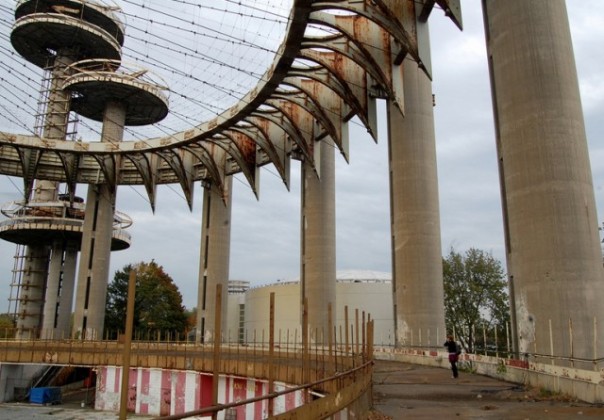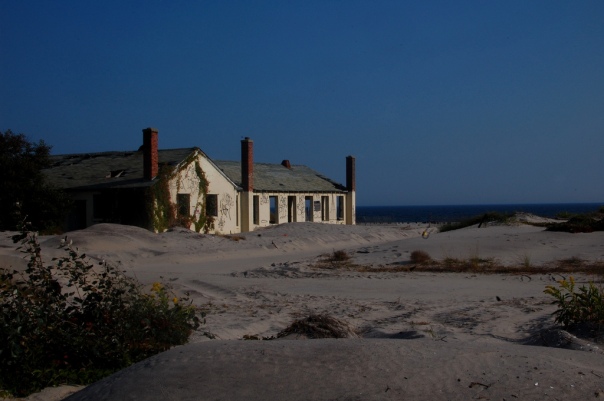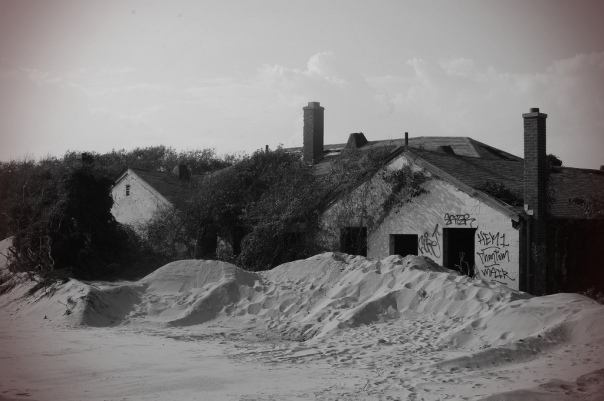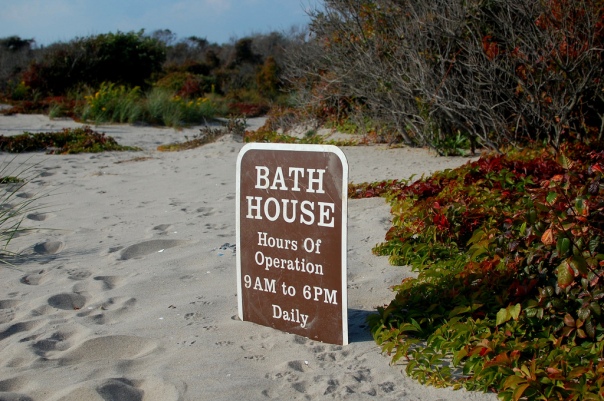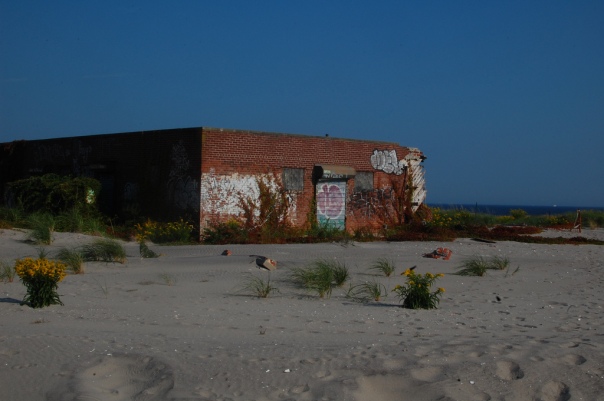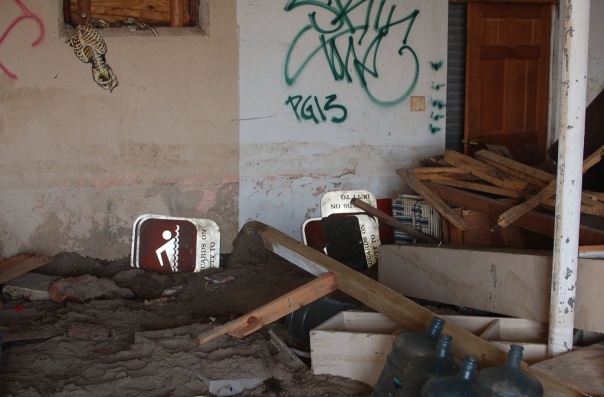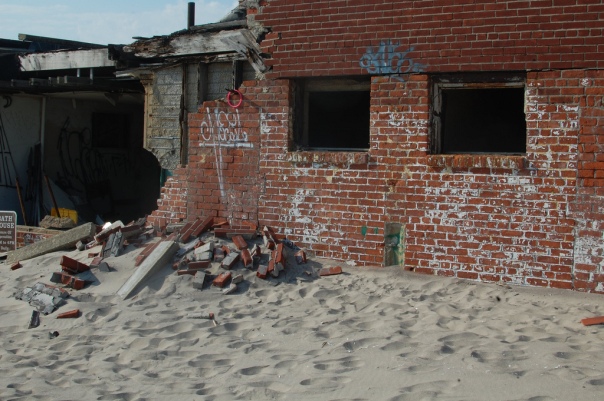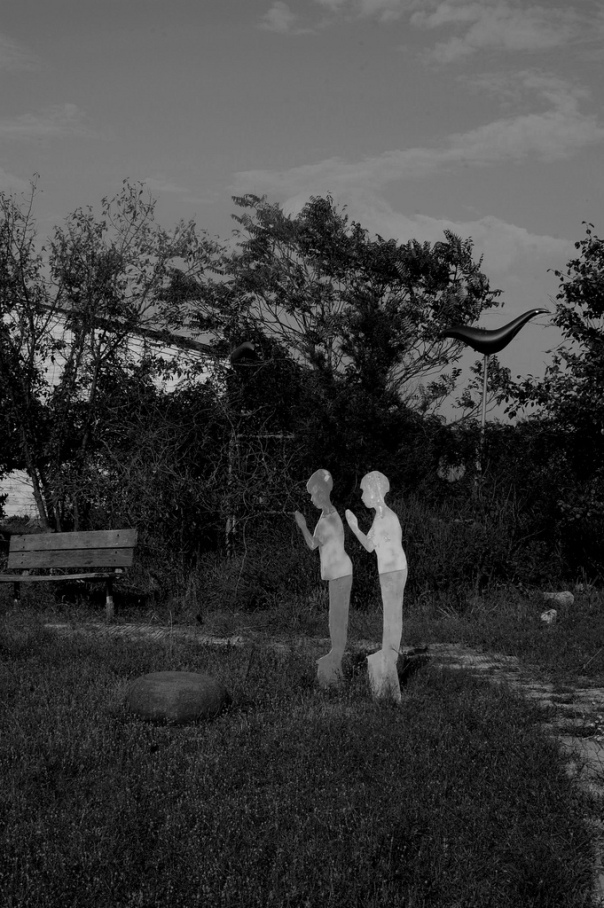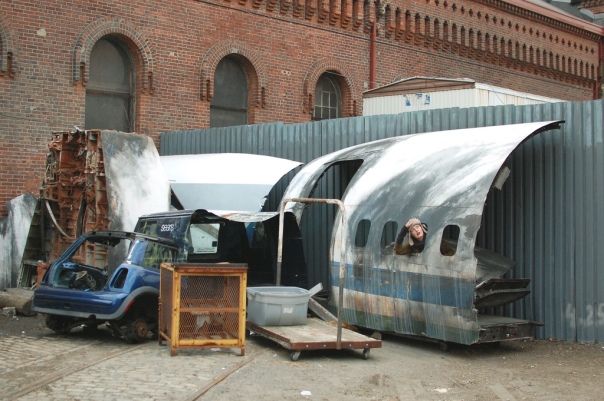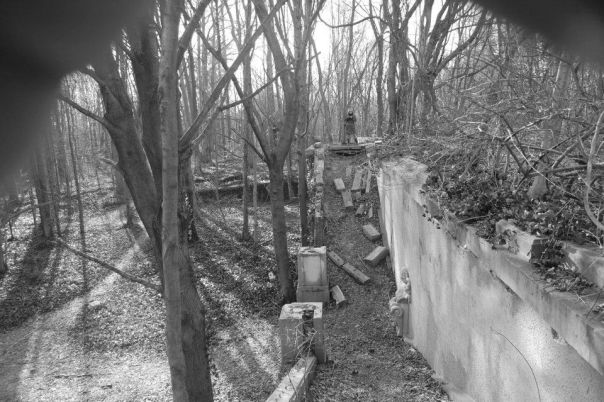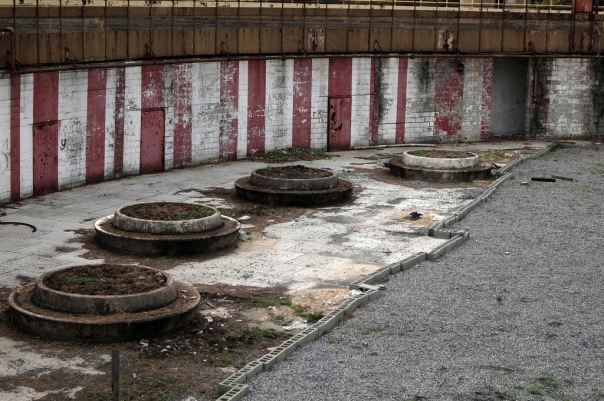Blog Archives
Walking the Queens World’s Fair Ruins – Seen on Gothamist
I took this photo some time ago along with others documenting the crumbling World’s Fair Grounds of Flushing Meadows-Corona Park.
It was featured on Friday’s Gothamist. $43 million is needed to restore the facilities and save them from destruction.
More of my pictures of the place are here: https://ventilateblog.wordpress.com/tag/worlds-fair-grounds/
Fort Tilden Revisited – one year after the Storm
A century ago, guardian of the Atlantic approach to NY Harbor. Artillery with a range of 25-miles pointed seaward waiting for the German ships that never came – save perhaps for a handful of shadowy U-boats, seen and unseen.
A patch of sandy desolation on the fragile narrow spit of the Rockaway Peninsula, which barely rises between ocean and the Jamaica Bay. In the distance, a proud Manhattan skyline – a mirage of a completely different world – hazy and not quite existent.
Wars of the sea gave way to wars of the air. The big guns were traded in for the Nikes, missiles designed to knock high-altitude Soviet bombers out of the Metropolitan sky.
And then, a few decades ago – total obsolescence, abandonment, and decay. Gutted shells, overgrown and sinking into the sand, which in turn, minute by minute, sinks into the waves. It’s lately been a playground of the fringes – artists, photographers, graffiti, and seekers of ramshackle ephemera.
The hurricane pummelled the city, and the peninsula took a huge punch, a slap in the face of human futility. For that night, the peninsula did not exist, but became ocean and bay – Neighborhoods near the isolated base washed away and burned. Sand piled high like snow drifts that never melt, overturned cars, buried homes and memories.
Pieces of Tilden dissolved into the waves. But what is already ruined is hard to ruin again. At this former fort, a few solid walls are down, the sand mounts high, and a faint, musty, low-tide smell still faintly emits from the ground below. But the gun battery embedded in the bluffs still stares blankly into the sea, awaiting 100-year-old dreadnoughts and battleships that will never appear. Since the Storm, it’s become barricaded, forbidden, heavily patrolled by the authorities – a no man’s land – A silent sentinel upon the wild dunes of a wild beach on the barren coastal fringes of the City.
Brooklyn Navy Yard
The Brooklyn Navy Yard dates to 1801, but the site was used for ship building since before the Revolution. Many a famous ship was born from the dry-docks here.
During World War II, when tens of thousands worked here around the clock, the Yard
was one of the mightiest forges of American naval power.
Its strategic importance was such that, in order to prevent covert surveillance from above, the sides of the Manhattan and Williamsburg Bridges were shrouded, – and the proposed Brooklyn-Battery Bridge was turned into a Tunnel.
Today it’s a vast industrial semi-wasteland- a desolate complex dotted with rusting warehouses and random junk …
King Zog’s Gold Coast Palace
Through the 1920’s and ’30’s, Ahmet Muhtar Zoggolli, a.k.a. Zog I, was prime minister of, president of, and finally, King of Albania. Among other eccentricities, he holds the world record for number of cigarettes smoked in one day (225!), and is said to have survived 55 assassination attempts- in one case, he personally engaged in a gun fight with an attacker.
“Oh God, it was so short” he uttered when he was exiled by invading Italian armies in 1939.
He and his family wandered Britain and Egypt, and in 1951 purchased the early-20th century Knollwood Estate in the Gold Coast of Long Island, New York.
He planned to bring his entire court to the U.S., but immigration laws impeded this. The entire American endeavor was a sad failure.
Zog eventually died in Paris ten years later. His Queen Geraldine passed in 2002.
It has been suggested that King Zog bought the Estate with diamonds and rubies, and that hidden treasure lay on or under the grounds.
After being ditched in the late ’50’s, it was torn down to prevent looting. So complete was the annihilation that only a few specks remain of the 60-room palatial mansion. The only remains are the front gate, a couple of gazebos, the base of a loggia, some garden walls… The most prominent survivor is the double staircase that led to what was once the front patio.
The silence here is striking and strange. Subtle traces of stonework emerge from the brambles, and you begin to notice features of the overgrowth that reveal landscaped patterns- well-aligned rows of large trees and such.
Ghosts abound. Echoes of all those who passed through what is now a sad patch of forest. Cigars smoked, gatherings had, all manner of passions and frustrations. Holidays, births, deaths, visits- all the trappings of both grand and humble living.
World’s Fair Grounds-revisited
During the summer I posted on the World’s Fair Grounds which hosted the worldwide exposition in 1939 and in 1964:
https://ventilateblog.wordpress.com/2011/07/16/worlds-fair-grounds-queens/
These are some photos from my most recent excursion:
Forgotten Fort Totten
150 years ago, at the edge of the city, on a point of land where the East River meets the Long Island Sound, where Queens washes into the suburbs, the federal government constructed Ft Totten. This was in 1862, when the Confederacy was at the height (at least psychologically) of its power. A paranoid North was engaged in bucking up its defenses for the terrible possibility that its cities would be threatened by the rebels.
Ft. Totten was intended to protect New York City’s northeastern maritime approach. Its construction was planned soon after the War of 1812, when the British sacking of the capital exposed a glaring lack of sea defense.
Parts of the fort still occupy the edge of the strait. The surrounding land is now divided amongst the NYPD, the FDNY, the Navy Reserve, and the Coast Guard. Despite the proximity of these high-powered agencies, the Fort itself is remarkably easy to infiltrate.
On this very stormy day, everything was drenched and water was everywhere – leaking through the cracks of fortified stone, puddling on time-worn floors, pouring from ceilings. There are doors that lead to dark tunnels and into cavernous cisterns, where no light penetrates and all sounds that enter are returned in the sort of echoes that only huge empty spaces could create.
This was sort of a random expedition, and we were not properly equipped with flashlights, otherwise we might have gone deeper. There are rumors that there exists a tunnel which burrows under the East River to Ft. Schuyler across in the Bronx.
Aside from the rushes of sweeping rain and wind, a damp silence takes eerie hold along the seaward gun turrets. At the very bottom floor, storm waves crash and spray through the windows and the stone walls respond with reverberant groans. The fort has been obsolete for a century, its officers long forgotten. A lonely single gun points to the water- waiting for an enemy that never came and never will come.
